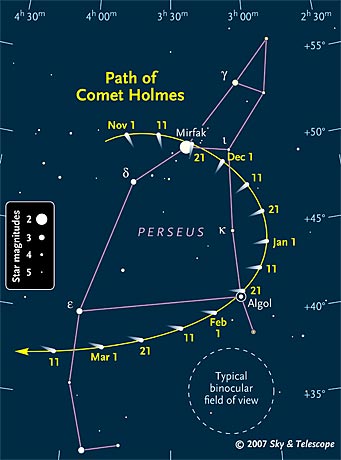| Click here to learn what astronomers think caused Comet Holmes to become so bright. Also, see our extensive collection of reader reports about the comet's changing appearance. Add yours! And check out our impressive gallery of Comet Holmes photos from skygazers around the world. |

Northern Hemisphere observers can locate Comet Holmes in the evening sky throughout the coming winter. Click image for larger view.
Sky & Telescope
After dark, go outside, find a spot where bright lights don’t glare into your eyes, and face northeast. Look high for the W-shaped constellation Cassiopeia, a landmark of the autumn sky. The W is standing on end, and it’s about the size of your fist held at arm’s length.
Look lower right of Cassiopeia by about a fist and a half at arm’s length. The brightest star there is Mirfak, also called Alpha Persei. Comet Holmes is close to Mirfak, as shown on the finder chart here.
(If you’re in the tropics or the Southern Hemisphere, the sky scene will be oriented differently; use our interactive sky chart to see how.)
Starting November 26th, there's a good dark-sky period between when twilight ends and the Moon rises (depending on the latitude where you live). This dark-sky window is only about a half hour long on the 26th (near latitude 40° north) but grows about an hour longer each night thereafter.
What’s Next?
Comet Holmes flared into visibility on October 24th. At first the expanding dust cloud around its icy nucleus appeared so small that it looked like a bright star to the unaided eye. Within days the cloud spread out wider, so that the “star” became a fuzzy round disk. Since then the disk has been getting wider every night, and as the dust has spread its brightness has greatly dimmed. As of late November the comet is about 0.7° wide, larger than the apparent diameter of the Moon.
Will Comet Holmes erupt again, as it did when discovered in 1892? Who knows? Take a look with binoculars every clear evening. This visitor will linger among the stars of Perseus for several months.
 0
0
Comments
You must be logged in to post a comment.